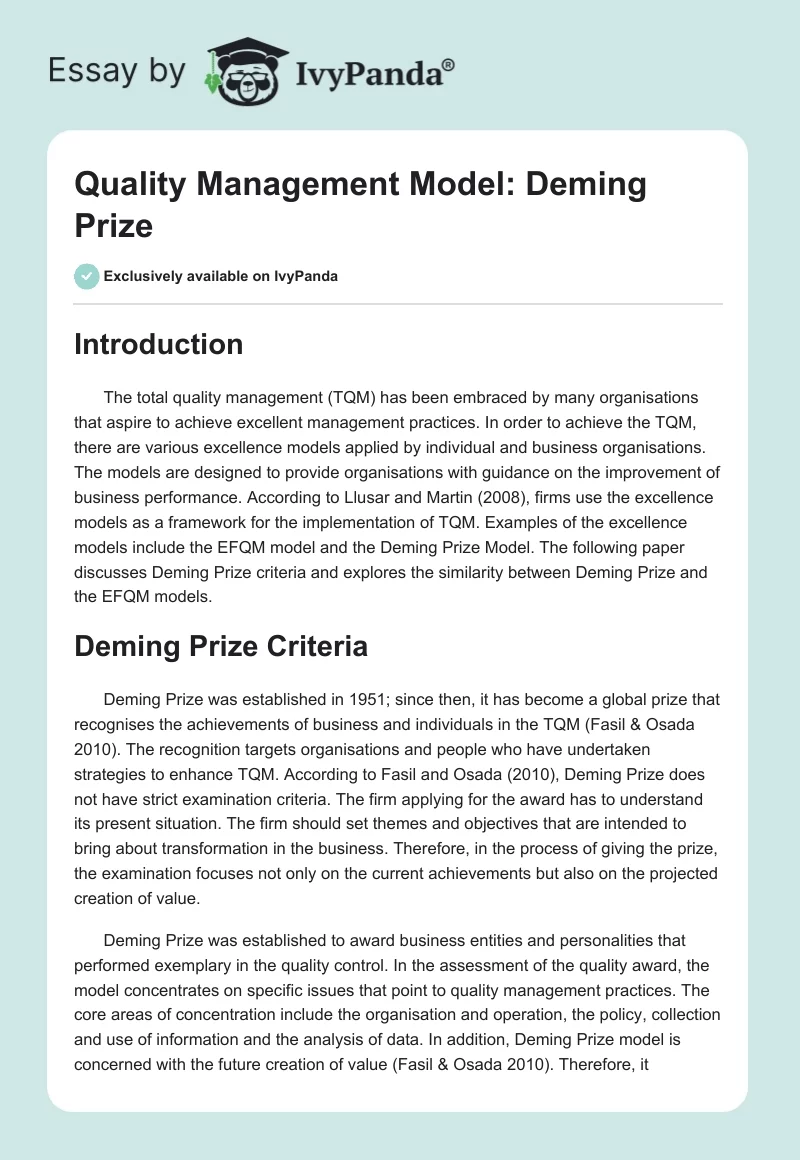Introduction
The total quality management (TQM) has been embraced by many organisations that aspire to achieve excellent management practices. In order to achieve the TQM, there are various excellence models applied by individual and business organisations. The models are designed to provide organisations with guidance on the improvement of business performance. According to Llusar and Martin (2008), firms use the excellence models as a framework for the implementation of TQM. Examples of the excellence models include the EFQM model and the Deming Prize Model. The following paper discusses Deming Prize criteria and explores the similarity between Deming Prize and the EFQM models.
Deming Prize Criteria
Deming Prize was established in 1951; since then, it has become a global prize that recognises the achievements of business and individuals in the TQM (Fasil & Osada 2010). The recognition targets organisations and people who have undertaken strategies to enhance TQM. According to Fasil and Osada (2010), Deming Prize does not have strict examination criteria. The firm applying for the award has to understand its present situation. The firm should set themes and objectives that are intended to bring about transformation in the business. Therefore, in the process of giving the prize, the examination focuses not only on the current achievements but also on the projected creation of value.
Deming Prize was established to award business entities and personalities that performed exemplary in the quality control. In the assessment of the quality award, the model concentrates on specific issues that point to quality management practices. The core areas of concentration include the organisation and operation, the policy, collection and use of information and the analysis of data. In addition, Deming Prize model is concerned with the future creation of value (Fasil & Osada 2010). Therefore, it concentrates on planning for the future, standardisation, quality effects, quality assurance, education and training (Fasil & Osada, 2010). The unique feature of Deming Prize is that it is open to individuals and organisations. This is unlike the other models that solely focus on organisations.
Similarities between Deming Award and EFQM
The European Foundation for Quality Management (EFQM) model provides a comprehensive view of a firm. The model it is used to establish how the management tools and techniques are applied to enhance operations in an organisation. According to Kaya and Reyhani (2007), EFQM model enables the stakeholders to understand the factors that influence the operations of an organisation and its achievements.
The EFQM has nine criteria that are divided into enablers and results. Results are made up of four criteria while the enablers comprise of five criteria. The nine criteria are further divided into sub-criteria. The main concentration of the criteria is on the leadership, strategy, policy, human resource management, resources and processes (Uysal 2012). Deming Prize is based on similar criteria that include the human resource, quality assurance, policies, standardisation, organisation, and future plans for value generation.
Both the EFQM and Deming Prize models focus on the current and the future achievements. For instance, EFQM is concerned with the establishment of a system that is effective; hence, the model focuses on the outcome. EFQM also emphasises on the partnerships and resources. The aspect is concerned with factors that enhance excellent organisation strategies aimed at managing the external and the internal resources. The objective is to support the policies and the strategies put in place by the leadership of an organisation. Thus, EFQM is based on balancing the current operations and the future needs of the organisation and the environment of operation.
On the other hand, Deming Model is concerned with the current situation and the future creation of value for an organisation (Kaya & Reyhani 2007). In addition, the two models admit the aspect of continuous improvement as a crucial process in the achievement of excellence in organisations. The models are designed on the ideology of TQM. The Deming Prize stresses on continuous improvement, which is achieved by use of various processes such as the statistical control.
EFQM model gives emphasis to the processes aimed at improving management in order to satisfy and to enhance the value for the stakeholders and the customers. According to Llusar and Martin (2008), EFQM model is intended to increase value. On the other hand, Deming Prize Model has processes that enhance the value of human resource development and the stakeholders.
Conclusion
The business excellence models are aimed at fostering the outstanding businesses practices in an organisation. The models are result oriented and they are designed based on the key concepts that generate value for the business. Deming Prize and EFQM are examples of excellent models designed to enhance the current situation and focus on the future creation of value for organisations. The criteria for the two models emphasise on similar aspects. However, Deming Prize model has a unique feature that recognises the achievements of individuals, unlike EFQM model that focuses on organisations only. Firms use the excellence models as a framework for the implementation of TQM.
References
Fasil, T & Osada, H 2010, ‘Process Techno-Innovation Using TQM in Developing Countries Empirical Study Of Deming Prize Winners’, Journal of Technology Management & Innovation, no. 5, vol. 2, pp. 111-123. Web.
Kaya, S & Reyhani, M 2007, ‘The comparison of ISO 9000: 2000 and EFQM Excellence Model for Apparel Sector’, Textile and Garment, vol. 4, no. 1, pp. 273-278. Web.
Llusar, J & Martin, I 2008, ‘An empirical assessment of the EFQM Excellence Model: Evaluation as a TQM framework relative to the MBNQA Model’, Journal of Operations Management, vol. 1, no. 1, pp. 624-641. Web.
Uysal, G 2012, ‘Total Quality Management Awards: Performance Acquisition’, Journal of US-China Public Administration, vol. 9, no. 4, pp. 451-457. Web.


